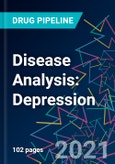Latest Key Takeaways
- The publisher estimates that in 2018, there were 223.1 million prevalent cases of major depressive disorder (MDD) worldwide, and forecasts that number to increase to 248.9 million prevalent cases by 2027.
- The drug market for depression is projected to expand in the next 10 years, propelled by a growing patient caseload and uptake of new products approved for indications beyond MDD, including post-partum depression (PPD), treatment-resistant depression (TRD), and suicidal ideation.
- The primary distinguishing factor in the depression market is a drug’s ability to satisfy unmet needs. The latest market entrants, Spravato and Zulresso, have appeared highly attractive in their capacity to fulfill needs through their approvals for difficult-to-treat patient populations coupled with their refreshing first-in-class mechanisms. Novelty in mechanism of action is a key differentiator that has finally reached the depression market after decades of stagnated innovation, since long-standing standard-of-care drug classes have been inadequate in treating depression. Traditional therapies may take four to six weeks to produce clinically meaningful effects, and refractory depression persists.
- Serotonergic antidepressants, such as selective serotonin reuptake inhibitors (SSRIs) and serotonin-norepinephrine reuptake inhibitors (SNRIs), are forecast to be dethroned from their market-leading positions by pioneering drug classes: steroidal antidepressants and N-methyl-D-aspartate (NMDA) receptor modulators. Although growth of the SSRI market will be spearheaded by Trintellix, traditional serotonergic antidepressants have largely been insufficient in treating depression, and the market is characterized by critical unmet need. This poses prominent opportunities for new therapeutic classes to diverge from the sluggish growth trends of established drug classes. Combined sales of the novel products Spravato, Zulresso, SAGE-217, AXS-05, d-methadone, and seltorexant will greatly expand the depression market.
- Sage Therapeutics’ steroidal antidepressant franchise will expand the market. The Phase III drug SAGE-217 is anticipated to become a market-leading brand, boasting a broad label to treat PPD, MDD, and co-morbid MDD with insomnia. Its launch for MDD as a monotherapy will be its greatest opportunity as it may be prioritized in the largest patient population. It will be the only launch for this indication that offers convenient, short-course oral dosing, a rapid onset of action, and a new approach to treatment that makes it very competitive compared to currently marketed therapies.
- In the PPD space, SAGE-217 will build on the market share of its sister product and first-to-market drug for PPD, Zulresso. Despite access hurdles resulting in a slow ramp-up in initial sales since launching in the US in June 2019, Zulresso possesses a robust clinical profile with remarkable, potent effects at 60 hours post-dose. Zulresso patients are expected to switch to the more conveniently administered SAGE-217 following initial Zulresso regimens. This synergy will make Sage Therapeutics’ brexanolone franchise a formidable one.
- First launched in the US in 2019, Spravato is expected to become a blockbuster brand. Johnson & Johnson has characterized its product well through extensive global studies that consolidate physicians’ off-label experience with the related drug ketamine. Crucially, the first-in-class drug is the second product approved by the FDA for TRD and has the potential to confer fast-acting benefits. Furthermore, it is also approved to treat MDD patients with suicidal ideation and behavior.
- Axsome Therapeutics’ multi-modal drug AXS-05 is an NMDA receptor antagonist, sigma-1 receptor agonist, and an inhibitor of the reuptake of monoamines. While the company filed for MDD in February 2021, the drug also has potential to broadly target different lines of therapy, from first-line and antidepressant-unresponsive MDD patients to TRD and patients with suicidal ideation, depending on the outcome of further trial investigations. Thus, Spravato will be a key competitor as it occupies later lines of therapy. While Spravato holds the benefit of earlier market entry, AXS-05 may secure a broader label and would offer the convenience of oral administration compared to Spravato’s intranasal spray administered by a healthcare professional.
- D-methadone is a clinically promising pipeline drug that would expand the NMDA class and enter as a more convenient oral competitor to Spravato for TRD. Demonstrating strong efficacy data with fast clinically meaningful responses at Phase III would allow d-methadone to be a significant competitor, especially if Relmada successfully expands investigations into MDD and enters into a strategic partnership to pool resources.
- Seltorexant is yet to produce convincing, robust clinical trial data as the drug’s efficacy appears to taper over time. Nevertheless, Johnson & Johnson is moving forward with Phase III investigations into seltorexant as an adjunctive treatment of MDD with insomnia symptoms since greater efficacy was evident in this patient population.
- Although there are vast opportunities for new drugs to achieve substantial sales, there are also risks. Potential barriers to eventual uptake include costliness hindering market access, safety issues that necessitate strict REMS programs, and niche target populations which will reduce a product’s commercial potential.
- Most long-established brands will not enjoy blockbuster growth. The only prominent established brand is Trintellix, and its strong clinical profile for MDD will continue to drive robust sales growth until its patent expiry in 2026 in the US. In contrast, sales of most traditional brands will generally continue to contract as ever-intensifying generic competition progresses through the forecast period covered by our analysis. Fetzima and Rexulti, which are yet to be impacted by generic erosion, will struggle to ramp up the same sales momentum in the crowded generic climate, primarily because they are not distinct enough from existing therapies in their mechanisms and indications. Their lack of novelty is in stark contrast to the new approaches presented by pipeline drugs for MDD such as SAGE-217 and AXS-05.
Table of Contents
OVERVIEW
DISEASE BACKGROUND
TREATMENT
EPIDEMIOLOGY
KEY REGULATORY EVENTS
LICENSING AND ASSET ACQUISITION DEALS
CLINICAL TRIAL LANDSCAPE
DRUG ASSESSMENT MODEL
FUTURE TRENDS
RECENT EVENTS AND ANALYST OPINION
UNMET NEEDS
BIBLIOGRAPHY
LIST OF FIGURES
LIST OF TABLES








